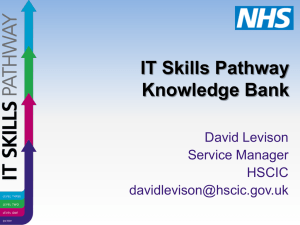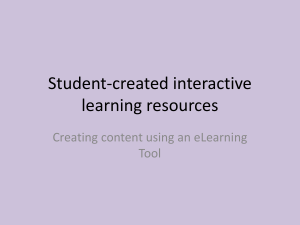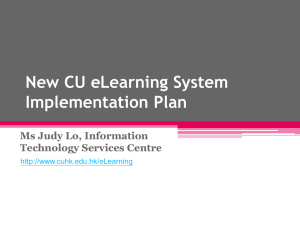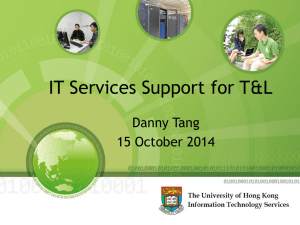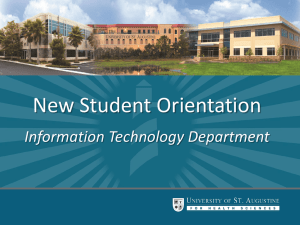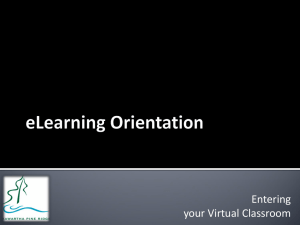Presentation
advertisement
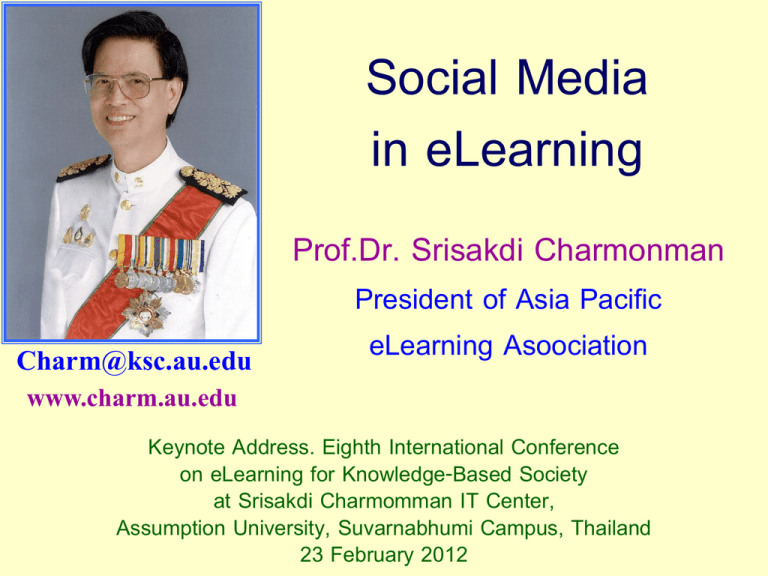
Social Media in eLearning Prof.Dr. Srisakdi Charmonman Charm@ksc.au.edu President of Asia Pacific eLearning Asoociation www.charm.au.edu Keynote Address. Eighth International Conference on eLearning for Knowledge-Based Society at Srisakdi Charmomman IT Center, Assumption University, Suvarnabhumi Campus, Thailand 23 February 2012 Co-Author. Rit Thirakomen President of MK Company and Founder of Se-Education Public Company Limited. 2 Co-Author. Pornphisud Mongkhonvanit President Siam Technology College Thailand Pornpisud@gmail.com www.siamtechu.net 3 Social Media in eLearning. 1. 2. 3. 4. 5. 6. 7. Introduction. Social Media Tools for eLearning. Social Media for Marketing of eLearning. Social Media in University-Level eLearning. Social Media in K12 eLearning. Social Media in Corporate eLearning. Concluding Remarks. 4 1. Introduction. Searching “Popularity of Social Media 2012” in Google, 76.8 million entries found. 5 Introduction (Cont.) From the ranking by www.ebizmba.com [6] in February 2012, the top five in terms of estimated monthly visitors: 1. FaceBook 750 million. 2. Twitter 250 million. 3. LinkedIn 110 million. 4. MySpace 71 million. 5. Google Plus 65 million. 6 Introduction (Cont.) Searching “Use of Social Media in eLearning” in Google, 27.1 million entries found. 7 Introduction (Cont.) Searching “Success Stories of Using Social Media in eLearning” in Google, 211 million entries found. 8 Introduction (Cont.) From J. Aleckson “2012 eLearing Predictions and How to Cope” [1], 10 predictions were made: 1) eLearning Master’s degrees proliferate. Invest in professional development with eLearning. 2) eLearning Integrated into High School Curricula. Enroll in an eLearning course. 9 Introduction (Cont.) 3) Integration of Formal Discussion Threads with Social Media Platforms. Join Social Media to collaborate and comment to formal courses. 4) Declining Interest in Tutorial Format. Come up with different ways to assemble just-in-time information. 10 Introduction (Cont.) 5) Tablet Use in eLearning. Use Apps instead of PowerPoint. 6) LMS will Control Tablet. Let all students be on the same page in live classroom. 11 Introduction (Cont.) 7) Online Micro-Lectures Impact eLearning Design. Develop ways to sell this concept to the non-believers. 8) Game Developers seek alternative to Flash. Dedicate one project to using an alternative platform in 2012. 12 Introduction (Cont.) 9) HTML 5 struggles to replace Flash in eLearning. Do not react until investment is available to use HTML 5 as a replacement to Flash. 10) LMS Satellites grow. It is alright to maintain more than one LMS in the cloud. 13 Introduction (Cont.) From E. Matas “Top 5 eLearning Skills for 2011” [10]: 1) Graphic Design. 2) Video Production. 3) Rapid Development. 4) Social Media. 5) Mobile Development. 14 Introduction (Cont.) With millions of entries from Google searches, only selected examples of literature survey will be presented in this paper. 15 2. Social Media Tools for eLearning. Searching “Social Media Tools for eLearning” in Google, 11.9 million entries found. 16 Social Media Tools for eLearning (Cont.) From <Theelearningcoach.com>, “10 Social Media Tools for Learning”. [20] 1) Audacity. An inexpensive option to Podcast. 2) Edublogs Campus. Software to centralize and manage blogs within an institution. 3) Elgg. A social networking engine and publishing platform for running your own social networking site on a server. 17 Social Media Tools for eLearning (Cont.) 4) “Go To Meeting” and “Go To Webinar”. An interactive webinar and live presentation. 5) Google Collaboration Tools for Education and Business, Google Apps Including: - Google Docs. - Google Video. - Google Sites. - Google Wave. - Google Conversations. 18 Social Media Tools for eLearning (Cont.) 6) MindMeister. A browser-based service for creating mind map. 7) TalkShoe. A free web-based service to create your own radio talk show. 8) VoiceThread. A tool for having discussions around media, such as a presentation, video or image. 19 Social Media Tools for eLearning (Cont.) 9) Wikispaces. A software for creating and editing interlinked web pages. 10) Yammer. A microblogging that provides a secure enterprise microblogging platform. 20 Social Media Tools for eLearning (Cont.) From P. Signorelli “Revolutionizing E-Learning: Innovation through Social Networking Tools”. [19], several examples were given, the one presented here is Smarthistory.khanacademy.org… [9]. 21 Social Media Tools for eLearning (Cont.) Smarthistory is a free, not-for-profit, multimedia eBook which may be used as a substitutes to traditional history book. Smarthistory is made possible by generous grants from the Samuel H. Kress Foundation. Smarthistory will continue to add new material. Smarthistory is looking forward to broader collaborations with history professionals. 22 Smarthistory. 23 Social Media Tools for eLearning (Cont.) As of February 2012, Smarthistory covers the history from 400 CE to 1907. Ancient Cultures Medieval Era Proto-Renaissance Renaissance in Italy and the North - 400 C.E. 400 –1300 1300 – 1400 1400 - 1500 24 The History from 400 C.E. to 1907 (Cont.) End of the Renaissance and the Reformation Age of Discovery, Reformation II, and the Baroque Age of Enlightenment Industrial Revolution I Industrial Revolution II 1500 - 1600 1600 – 1700 1700 - 1800 1800 - 1848 1848 - 1907 25 Social Media Tools for eLearning (Cont.) From <www.trivantis.com> “eLearning Industry Leader Hosts Social Media Contest”. [22], social media contest for eLearning was presented. The contest ran for about 1 month, from 12 January 2012 to 15 February 2012. 26 Social Media Tools for eLearning (Cont.) Twitter and FaceBook are used concerning eLearning projects: - To discuss. - To post questions. - To provide answers. - To share experiences. 27 Social Media Tools for eLearning (Cont.) From <waithash.com>, “How to Use Social Media as a Learning Tool.” [24], Social Media allow users to: - Make information available. - Help learners to connect. - Help learners to engage. - Help learners to collaborate. - Help learners to share eLearning experience. 28 Social Media Tools for eLearning (Cont.) The tools are: - Search-Engines, especially Google Scholar. - Blogs, especially by professionals. - Twitter. - FaceBook. - File-Sharing and Collaborations especially Dropbox.com, Google docs, and Wikis. 29 Social Media Tools for eLearning (Cont.) - Video sharing, especially YouTube educational videos. - LMS, such as Moodle, Sakai, Blackboard, etc. - Social Bookmarking, such as delicious.com 30 3. Social Media for Marketing of eLearning. In this paper on “ASEAN University-Level eLearning”. [4], the first author stated that marketing is a very important factor for success or failure of eLearning programs. The purpose of eLearning marketing is to recruit students. 31 Social Media for Marketing of eLearning (Cont.) University of Phoenix has been highly profitable because it was highly successful in recruiting students UKeU (UK eUniversity) was disbanded because it got very small number of students comparing to the target. 32 Social Media for Marketing of eLearning (Cont.) In this paper on “Recruiting Student for University-Level eLearning”. [5], the authors discussed social network for recruitment of students. 33 Social Media for Marketing of eLearning (Cont.) A. H. Omer presented five social media marketing tips for eLearning [12]: 1) Use blogs to discuss cost effective training, authoring tools, instructional design strategies and theories. 2) Use LinkedIn to engage in discussions. 34 Social Media for Marketing of eLearning (Cont.) 3) Use YouTube to demonstrate your products. 4) Offer courses to induce students to take paid courses. 5) Use Twitter and FaceBook to inform potential customers. 35 Social Media for Marketing of eLearning (Cont.) L. Overton discussed how to make social media work in eLearning [14]. 1) Master the art of conversation, especially to engage potential students on what they are interested in. 36 Social Media for Marketing of eLearning (Cont.) 2) Understand your audiences, especially by observing your staff and students’ reactions. 3) Find where the conversation are happening and go there. Popular social sites are FaceBook, Yahoo, LinkedIn, Skype, and Twitter. 37 Social Media for Marketing of eLearning (Cont.) 4) Sharing great content is at the heart of engagement, especially contents that are useful and informative, to keep the potential students wanting more. 5) Master the tools that align to business strategy. It you do not know the tools well, you cannot use them effectively. 38 Social Media for Marketing of eLearning (Cont.) J. Ballas shared his insight on FaceBook marketing [2]. 1) Online to exceed print advertising in 2012. By 2016, the projection is: US$ 62 billion for online. US$ 32 billion for print. 39 Social Media for Marketing of eLearning (Cont.) 2) Two Key types of Facbook marketing: - Free by posting your content on your business FaceBook page and run competitions and surveys. - Paid to accelerate your presence online. 40 Social Media for Marketing of eLearning (Cont.) W. Oppelbaumer presented his idea on Using Twitter in eLearning [13]. 1) Follow the Subject Matter Experts (SME). Let the students tweet questions to SME to answer. 2) Follow the Subject. Use a hashtag to keep the conversation going. 3) Build a community to let learners share there thoughts. 41 4. Social Media in University-Level eLearning. From P. Signorelli “Revolutionizing E-Learning”. [19], examples of use of Social Media in eLearning are: - Wikipedia-style collaborations. - Social Networking Tools such as * Online Discussion Boards. * Live Chats. * Twitter. * YouTube. * Communities. 42 Social Media in University-Level eLearning (Cont.) From E. Hoffman “Social Media and Learning Environment”. [7], Social Media changed authority from the teachers to the students. Teaching-elearning initiatives in higher education has been: - Under-funded. - Poorly coordinated. - Too rapidly moved to the new high-prestige trend. 43 Social Media in University-Level eLearning (Cont.) Hoffman stated that Social networking provides novel affordances for computer-supported collaborative learning. 44 Social Media in University-Level eLearning (Cont.) From S. Minocha “A Study on the Effective Use of Social Software”. [11], educational goals for using Social Media are: - Initiating new ways of learning. - Giving control to student. - Providing transferable skills. 45 Social Media in University-Level eLearning (Cont.) - Supporting peer-to-peer learning. - Enhancing reflective learning. - Creating a digital identity. - Fostering social engagement. 46 Social Media in University-Level eLearning (Cont.) Benefits from using Social Media in Higher Education include: - Retention. - Socialization. - Collaborative learning. - Student engagement. - Sense of control and ownership. - Problem-solving. 47 Social Media in University-Level eLearning (Cont.) - Sense of achievement. - Visibility of artifacts created. - Integrative of multimedia. - Adding novelty and excitement to the learning environment. - Overcoming isolation and geographic difference. - Students’ positive perception of the teachers. 48 Social Media in University-Level eLearning (Cont.) From <www.prnewswire.com/news-releases/newuniversity-of-phoenix-social-network-connects…> [15], on 24 September 2010, University of Phoenix announced “PhoenixConnect” which is its own Social Network for students, alumni and faculty. 49 Social Media in University-Level eLearning (Cont.) During the first week of announcement the adoption rate was 95%. As of 31 August 2010, Phoenix has 470,800 students. 50 Social Media in University-Level eLearning (Cont.) Some of the resources offered by PhoenixConnect include: - Academic for professional networking. - Tools for collaboration and discussion. - Personalized profiles. - Directory of all active PhoenixConnect Communities. - Recent activity feed. - Widget displaying people with similar interest. 51 Social Media in University-Level eLearning (Cont.) From the University of Phoenix web [23], PhoenixConnect provides: - Academic and professional conversations. - Answers to questions. - Updates activities stream. - User profile. - Status updates. 52 Social Media in University-Level eLearning (Cont.) - Network and connect. - Joining or starting a group. - Keeping up with University news and announcements. - Establishing privacy settings. 53 Social Media in University-Level eLearning (Cont.) From <www.capellacommons.com> [3], as of 30 June 2011, Capella University has more than 38,000 students from 50 states of the US and 59 other countries. 54 Social Media in University-Level eLearning (Cont.) Capella Commons is the Social Networking portal from Capella University students, faculty and staff to share: - Blogs. - Podcasts. - Photos. - Others. 55 Social Media in University-Level eLearning (Cont.) Capella also has FaceBook pages: - Capella official FaceBook page. - Capella’s Military and Veterans FaceBook page. - Capella’s Mental Health FaceBook page. - Capella’s Higher Education FaceBook page. - Capella’s Doctoral Degree Programs FaceBook page. 56 5. Social Media in K12 eLearning. From thejournal.com. “5 K-12 E-Learning Trends”. [21], , B. McCrea stated that popular in classrooms, social networking such as FaceBooking and Twittering become popular in classrooms. 57 Social Media in K12 eLearning (Cont.) K-12 sector should use Social Networking to its advantage. A Program Director at Walden University recommended: - FaceBook. - Twitter. - Delicions. - Diigo. 58 Social Media in K12 eLearning (Cont.) Using Diigo, teachers can - Set up electronic reading lists. - Post assignments. Using Diigo, students can - Access on their own time. - Read the posting without having to wait for email. 59 Social Media in K12 eLearning (Cont.) From K. Waters. “google+ May Open Social Networking for some K-12 Schools”. [25], the author commented that: - Special care must be used to safeguard K-12 student’ personal information in using social network. Because of privacy concern. 60 Social Media in K12 eLearning (Cont.) K-12 schools have blocked student access to: - FaceBook. - Twitter. - Flicker. With better privacy safeguard, many K-12 schools have allowed Google+. As of August 2011, Google+ has more than 25 million users. 61 Social Media in K12 eLearning (Cont.) To control users’ privacy, Google+ provide a feature called “circle” for users to divide their contacts into groups and specially which group can access which information. 62 Social Media in K12 eLearning (Cont.) From C. Kanfman. “Top 10 e-learning trends in Kindergarten to grade 12”. [8], the author stated that: - eLearning has become a part of K-12 standard curriculum. - social networking provides new level of: * Interaction. * Communication. * Collaboration. 63 Social Media in K12 eLearning (Cont.) The K-12 generation is familiar with social networking forums. When properly supervised, Twitter and FaceBook have a place in K-12 classrooms. 64 Social Media in K12 eLearning (Cont.) At the Science Leadership Academy in Philadelphia, K-12 students use social networking to: - Message each others. - Share documents and blogs. - Upload their work onto school network. - Make their work available thru podcast. 65 6. Social Media in Corporate eLearning. From S. Rogers. “Corporate eLearning Coming to a Boardroom Near You”. [16], the author stated that: - Corporate eLearning is the way of the future. * Bringing people together even when they are thousands of miles apart. 66 Social Media in Corporate eLearning (Cont.) * Cutting costs. * Reducing the environment impact of business travel. - Social Media is definitely a part of corporate eLearning. 67 Social Media in Corporate eLearning (Cont.) Technology for corporate eLearning are: - Social networking. - Multi-authored blogs. - Social networking games. - Instant messaging. - Video Conferencing. 68 Social Media in Corporate eLearning (Cont.) From B. Schlenker. “Corporate eLearning Strategies and Development”. [17], the author stated that: - Social Media is no longer a trend but the main stream of communicating. - Social Media is not a skill but a practice. 69 Social Media in Corporate eLearning (Cont.) - Knowledge of how to use Social Media is gained by being embedded in it. - Corporate eLearning developers should (If not already done): * Get a Twitter account. * Join LinkedIn group. * Join FaceBook group. * Etc. 70 Social Media in Corporate eLearning (Cont.) - For Learning Development Practitioners: * If your corporate does not have Social Media solution in place, do not think about it in your design. 71 Social Media in Corporate eLearning (Cont.) * If your corporate has Social Media solution in place, get people to: Connect. Participate. Engage. 72 Social Media in Corporate eLearning (Cont.) - For Training Managers: * Engage with your IT department. * Begin conversations on how to leverage Social Media functionality. 73 Social Media in Corporate eLearning (Cont.) * If your IT department is already familiar with Social Media, find out who’s using it, how and when in under to use Social Media in eLearning effectively. 74 Social Media in Corporate eLearning (Cont.) From A. Shea. “Corporate Learning and Social Media ROI: Show Me the Money”. [18], the author stated that: - What you get from Social Media depends on what you put into it. - ROI on Social Media on Corporate eLearning may be difficult to determine. 75 Social Media in Corporate eLearning (Cont.) - In Social Media, there are many indices to use: * Number of Tweets. * Number of FaceBook likes. * Number of Visit to blogs. * Number of Comments. * Etc. 76 Social Media in Corporate eLearning (Cont.) - HP showed how an integrated Social Media Center for sales force corporate eLearning training saved US$ 7,500 per learner compared to traditional training. - Chrysler cut delivery time of training to dealer from 2 weeks to a single day. 77 Social Media in Corporate eLearning (Cont.) - Cisco created an integrated Social Media platform with: * Videos. * Podcasts. * Learning Modules. * Games. 78 Social Media in Corporate eLearning (Cont.) * Discussion Forums. * Communities. * Mentoring Connections. * Individual Profiles. * Site-wide Search. 79 Social Media in Corporate eLearning (Cont.) * Wikis. * Blogs. * Tagging. * Social Bookmarking. * Polls. * RSS Feeds. 80 Social Media in Corporate eLearning (Cont.) - Cisco was honoured for its Social Media in Corporate eLearning with Brandon Hall Group Gold Award. 81 7. Concluding Remarks. Social Media have been successfully used in eLearning. All parties concerned must follow the use of Social Media in eLearning. 82 Concluding Remarks (Cont.) There who have not used Social Media in eLearning must try to do so. There who have been Social Media in eLearning must find more ways to use it more effectively for the benefits of all concerned. 83 Reference. 1. Aleckson, J. “2012 eLearning Predictions and How to Cope”. managingelearning.com/ /2011/12/28/547/. Posted on December 28, 2011. Accessed on February 3, 2012. 84 Reference (Cont.) 2. Ballas, J. “An Insight into FaceBook Marketing Infographic”. www.jeffbullas.com/2012/02/17/an-insight-intofacebook-marketing-infographic/. Accessed on February 2, 2012. 3. Capella University. “Capella Commons”. www.capellacommons.com. Accessed on February 4, 2012. 85 Reference (Cont.) 4. Charmonman, S. “Regional Report 2008 on ASEAN University-Level eLearning”. Proceedings of the Fifth International Conference on eLearning for Knowledge-Based Society, 11 - 12 December 2008. pp. 2.1 – 2.13 86 Reference (Cont.) 5. Charmonman, S. and Mongkonvanit, P. ”Recruiting Students for University-Level eLearning”. Proceedings of the Seventh International Conference on eLearning for Knowledge-Based Society, 16 – 17 December 2010. pp. 1.1 – 1.5 6. eBizMBA. “Top 15 Most Popular Social Network Sites, February 2012”. www.ebizmba.com/ articles/social-networking-websites. 87 Accessed on February 1, 2012. Reference (Cont.) 7. Hoffman, E. “Social Media and Learning Environments: Shifting Perspectives on the Locus of Control”. ineducation.ca/article/social-media-andlearning-environments--perspectives-locus-control. Accessed on February 4, 2012. 8. Kaufman, C. “Top 10 e-Learning Trends in Kindergarten to grade 12”. www.onlineschools.com/in-focus/10-elearning-trends. 88 Accessed on February 5, 2012. Reference (Cont.) 9. Khanacademy.org. “Smarthistory”. Smarthistory.khanacademy.org /aboutsmarthistory.html. Accessed on February 3, 2012. 10. Matas, E. “Top 5 eLearning Skills for 2011”. elearningweekly.wordpress.com/2011/02/27/top-5elearning-skills-for-2011/. Posted on February 27, 2011 . Accessed on February 1, 2012. 89 Reference (Cont.) 11. Minocha, S. “ A Study on the Effective Use of Social Software by Further and Higher Education in the UK: Learning and Engagement”. kn.open.ac.uk/public/workspace.cfm?wpid=8655. Accessed on February 4, 2012. 90 Reference (Cont.) 12. Omer, A.H. “Five Social Media Marketing Tips for eLearning Industry”. blog.commlabindia.com/elearning/five-social-mediamarketing-tips-for-the-e-learning-industry. Posted on May 11, 2009. Accessed on February 1, 2012. 91 Reference (Cont.) 13. Oppelbaumer, W. “Three Practical Ideas for Using Twitter in E-Learning”. www.articulate.com/rapidelearning/three-practical-ideas-for-using-twitter-ine-learning/. Posted on August 4, 2009. Accessed on February 3, 2012. 92 Reference (Cont.) 14. Overton, L. “How to Make Social Media Work in eLearning by following these top tips from marketing”. insights.elearningnetwork.org/?p=554. Posted on December 21, 2011. Accessed on February 2, 2012. 93 Reference (Cont.) 15. PRNewswire. “New University of Phoenix Social Network Connects Students, Alumni and Faculty for Personal Success”. www. prnewswire.com/news-releases/newuniversity-of-phoenix-social-network-connectsstudents-alumni-and-faculty-for-personal-success105336923.html. Accessed on February 4, 2012. 94 Reference (Cont.) 16. Rogers, S. “Corporate eLearning: Coming to a Boardroom Near You”. www.mnn.com/green-tech/researchinnovations/stories/corporate-elearning-coming-toa-boardroom-near-you. Posted on May 11, 2011. Accessed on February 4, 2012. 95 Reference (Cont.) 17. Schlenker, B. “Corporate eLearning Strategies and Development”. elearndev.blogspot.com/2011/03/practicing-socialmedia-skills-for.html. Posted on March 18, 2011. Accessed on February 3, 2012. 96 Reference (Cont.) 18. Shea, A. “Corporate Learning and Social Media ROI: Show Me the Money”. www.quicklessons.com/blog/2011/05/corporatelearning-social-media-roi-show-me-the-money/. Posted on May 9, 2011. Accessed on February 3, 2012. 97 Reference (Cont.) 19. Signorelli, P. “Revolutionizing E-Learning: Innovation through Social Networking Tools”. www.learningsolutionsmag.com/articles/128/revolutio nizing-e-learning-innovation-through-socialnetworking-tools. Posted on October 12, 2009. Accessed on February 3, 2012. 98 Reference (Cont.) 20. Theelearningcoach.com. “10 Social Media Tools for Learning”. theelearningcoach.com/elearning2-0/10social-media-tools-for-learning/. Accessed on February 2, 2012. 21. Thejornal.com. “5 K-12 E-Learning Trends”. thejournal.com/articles/2012/02/02/5-k12-e-learningtrends.aspx?page=1. Accessed on February 5, 2012. 99 Reference (Cont.) 22. Trivantis.com. “e-Learning Industry Leader Hosts Social Media Contest”. www.trivantis.com/e-learningindustry-leader-hosts-social-media-contest. Posted on January 12, 2012. Accessed on February 3, 2012. 23. University of Phoenix. “PhoenixConnect Academic of Social Network”. www.phoenix.edu/students/howit-works/innovative_education_technology/phoenixconnect.html. Accessed on February 4, 2012. 100 Reference (Cont.) 24. Waithash.com. “How to Use Social Media as a Learning Tool”. waithash.com/2011/07/how-to-usesocial-media-as-a-learning-tool/. Posted on July 8, 2011. Accessed on February 14, 2012. 101 Reference (Cont.) 25. Waters, J.K. “Google+ May Open Social Networking for Some K-12 Schools.” thejournal.com/articles/2011/08/24/google-may-opensocial-networking-for-some-k12-schools.aspx. Accessed on February 4, 2012. 102
